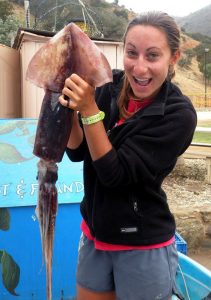A sea of unanswered questions about humboldt squid
by Virginia Ansaldi, RJ Dunlap Marine Conservation Program lab manager

Magen Schifiliti holds up one of the Humboldt squid from Buttonshell beach for a picture. Photo courtesy Magen Schifiliti.
A year ago, I moved out to California to take a job on Catalina Island as an outdoor educator. I worked through the spring and summer, but then my love affair with the island was brought to an end, as I was to attend graduate school back in Miami at the start of fall.
Shortly after leaving the island, my friends there told me that a bizarre amount of Humboldt squid had washed up on the shores of the camp’s cove. Enthralled with pictures of these sci-fi looking creatures, I decided to find out just why so many of them had come to rest on Buttonshell beach.
Dosidicus gigas, also known as the jumbo flying squid or the Humboldt squid (from its prevalence in the Humboldt current), has a historical range from Chile to Baja California. It is occasionally found as north as San Francisco, but never in large numbers or over an extended amount of time, according to a publication titled “Humboldt Squid Migrating to California Waters,”. Video and data collected from 1989 to 2007 by Bruce Robison, and others from the Monterey Bay Aquarium Research Institute were reviewed to study changes in abundance of the Humboldt squid.
PhD Louis Zeidberg of Stanford declared no observation of Humboldt squid in the remote operated vehicle (ROV) cameras from 1989 to 1997. However, in 1997 a number of the squid were counted. The scientists realized that the sighting coincided with an intrusion of warm water into the bay from a strong El Nino event that year.
